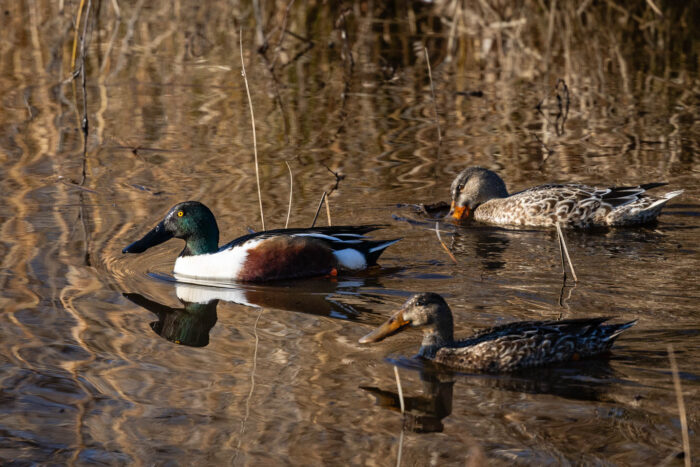Northern Shoveler
Anas clypeata
Also known as the spoonbill, the northern shoveler is a medium-sized dabbling duck with a distinctive shovel- or spoon-shaped bill, which it uses to separate particles of food from the water.
This section shows one large critter image at a time. Use the thumbnails that follow to select a specific image to display here.

This gallery contains a grid of small thumbnails. Selecting a thumbnail will change the main image in the preceding section.
Appearance
The northern shoveler has a large shovel- or spoon-shaped bill that is twice as wide at its tip than at its base, and equipped with a row of bristles or comb-like structures used to filter food from the water. Males and females have different patterns and coloring. Drakes, or males, have an iridescent green head, white breast, chestnut-brown flanks, black back. Their bill is dark gray or black and their eyes are yellow. Males have a wingspan around 31 inches. Females are mottled buffs and browns, with grayish yellow bills marked with orange on edges. Both sexes have pale blue patches on their inner forewings, as well as orange legs and feet. Immature ducks and non-breeding males resemble adult female in appearance, although non-breeding males can often be identified by a white streak located behind bill.
Feeding
Northern shovelers are omnivorous, feeding on crustaceans, mollusks, small minnows, insects and their larvae, seeds and aquatic plants. They forage in shallow water over mud bottoms, swimming along with their bill lowered. Before they can eat their food, they must push water and mud through their closed bill's filtering bristles. Social feeding is common. Shovelers are drawn to feeding areas by other birds, and will take advantage of food particles that other swimming or wading birds have churned to the water's surface. Single birds may swim in tight circles to create whirlpools and stir up particles of food.
Predators
Common waterfowl predators in North America include red fox, raccoon, owls, hawks, large gulls, mink, weasels, skunks, coyotes and crows.
Flight
Northern shovelers are strong and direct fliers. When alarmed, they will twist and turn, revealing pale blue patches on their inner forewings.
Voice
The male's call is a low took, took, took, while the female's is a light quack.
Reproduction and life cycle
Breeding takes place in spring. Males exhibit elaborate courtship behavior, including various calls, turns, dips and wing flaps. Nests are constructed on dry land close to fresh water, often surrounded on at least three sides by vegetation. Female forms neat cup by twisting her body on the ground. Nests are built of grasses and lined with female's down feathers. Female lays between eight and 12 pale greenish gray or olive-colored eggs. Incubation is by the female alone, begins once all eggs are laid and lasts 23 to 25 days. When flushed off her nest, a female often defecates on her eggs, apparently to deter predators. Ducklings hatch with typical duck bill that enlarges as duckling matures. Young start following female almost immediately after hatching. Young can fly after 40 to 45 days, after which the birds are independent.
Did you know?
- During the heat of the day, northern shovelers often rest on mud next to the water.
- Shoveler pairs are monogamous, remaining together longer than pairs of other dabbling duck species.
- A game bird, northern shovelers are often shot by hunters because of their resemblance to mallards.
Sources and additional information
- Life in the Chesapeake Bay by Alice Jane Lippson and Robert L. Lippson
- Anas clypeata: northern shoveler – University of Michigan Museum of Zoology
- Shoveler (Anas clypeata) – ARKive
